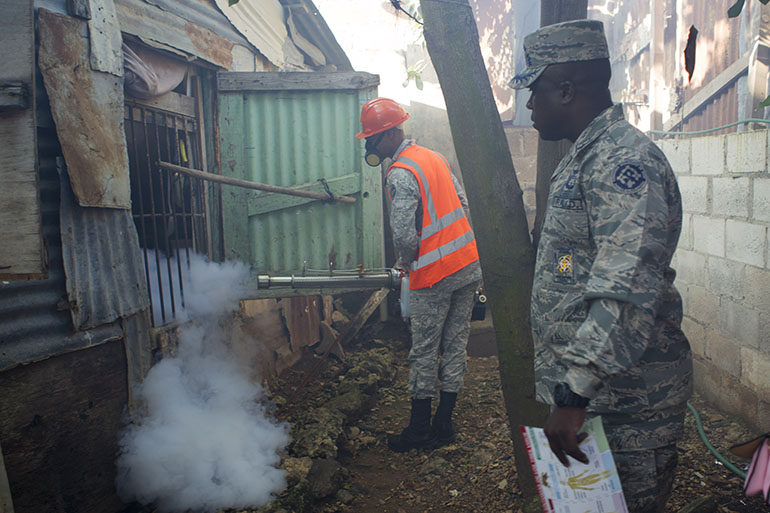More than 1,400 Americans contracted Zika while traveling outside the U.S. this year and a Caribbean-island nation is one of the top destinations where they caught the virus.
Visitors to the Dominican Republic account for more than a fifth of the confirmed Zika cases in the U.S. through mid-July, according to data from state health departments. New York, Florida and California alone tally 304 cases linked to the country, the data show.
As Florida officials investigate what may be the first non-travel-associated cases of Zika infection in the U.S., Kaiser Health News looked more deeply into the origins of the 1,404 travel-related cases reported by all states to the Centers for Disease Control and Prevention.
For most people, Zika causes flu-like symptoms. Pregnant women are considered especially at risk of the threat because Zika can cause severe birth defects, such as microcephaly.
The CDC does not break out the cases it tracks by country of origin — only by the infected person’s state of residency. It said in June that 48 percent of the travel-associated cases for all of 2015 and through May of this year originated in the Caribbean, 26 percent in Central America and 23 percent in South America. The cases numbered 591 at that time.
Data from the four health departments that have reported more than half of the national case total — New York state, New York City, Florida and California — provide additional detail.
More people who visited the Dominican Republic in 2016 returned with Zika than did U.S. residents who traveled to Puerto Rico, Colombia, Jamaica, El Salvador, Haiti, Guyana and Venezuela combined, the four departments’ figures show.
What’s the explanation? In part, it reflects travel patterns between people living in the U.S. with family members in the Caribbean nation, public health officials say.
“It’s not really tourists going back and forth,” said Chris Barker, a researcher in the School of Veterinary Medicine’s Department of Pathology, Microbiology and Immunology at the University of California, Davis.
Dominican Republic immigrants are the fifth-largest Hispanic group in the United States, numbering 960,000 in 2012, according to the Migration Policy Institute. Their highest population concentrations are in New York, New Jersey and Florida. Dominicans comprise New York City’s largest Hispanic group and “have a significant travel exchange with the Dominican Republic,” according to the city’s health department.
It counts 207 travel-associated cases linked to the republic, followed by 27 to Puerto Rico and 20 to Jamaica.
“Dominicans, Puerto Ricans and Guyanese do not have a higher risk of transmission for Zika infection,” the department said in a statement. “The data we have released simply reflects New York City’s demographics and travel patterns.”
People who travel outside the U.S. to visit family tend to make longer visits and often stay in residential locations, instead of “more sanitized areas made for tourists,” and that may increase their chances of getting bitten by a Zika-infected mosquito, Barker said.
Travel-related Zika cases are a function of both travel volume and how active the virus is in countries being visited, according to Barker. “When there is a high level of both, that is where you have the most cases,” he said.
Knowing which countries account for the most Zika travel cases helps drive public education efforts, said Vicki Kramer, chief of the vector-borne disease section at the California Department of Public Health.
As in New York City and Florida, California’s Zika statistics are also linked to immigrant populations there. Of California’s 77 cases, the greatest numbers resulted from travel to El Salvador, Honduras and Guatemala, all countries where state residents go to see family and often make extended visits, Kramer said.
New York City’s Health Department said it has done “extensive outreach” to local communities with strong ties to countries where Zika is active.
“These data could mean that Dominican New Yorkers are paying attention and testing more than other groups, which, in a way, is encouraging for us,” a statement from the department said.
With a population of about 10 million, the Dominican Republic shares the island of Hispaniola with Haiti.
Comparing U.S. data with a dataset from an international public health group indicates many more American visitors to the Dominican Republic have contracted Zika than residents of the island. The Pan American Health Organization reports 101 locally acquired cases there.
Brazil’s cases — 64,311 in total — account for almost 80 percent of the Zika infections in the Western Hemisphere through July 14, according to the organization. The country is so vast that infections are more spread out than in other areas of Central and Latin America, Barker said.
Public health sources for Zika statistics for the same country can vary. Puerto Rico’s tally is 2,162 on the Pan American Health Organization’s site. The CDC reports 2,843 locally acquired cases.
But among American travelers to both Brazil and Puerto Rico, the numbers appear to be far smaller, according to KHN’s analysis.
Those figures show 80 travel-related cases linked to Puerto Rico and six to Brazil. Colombia was at 46 and El Salvador at 31.








